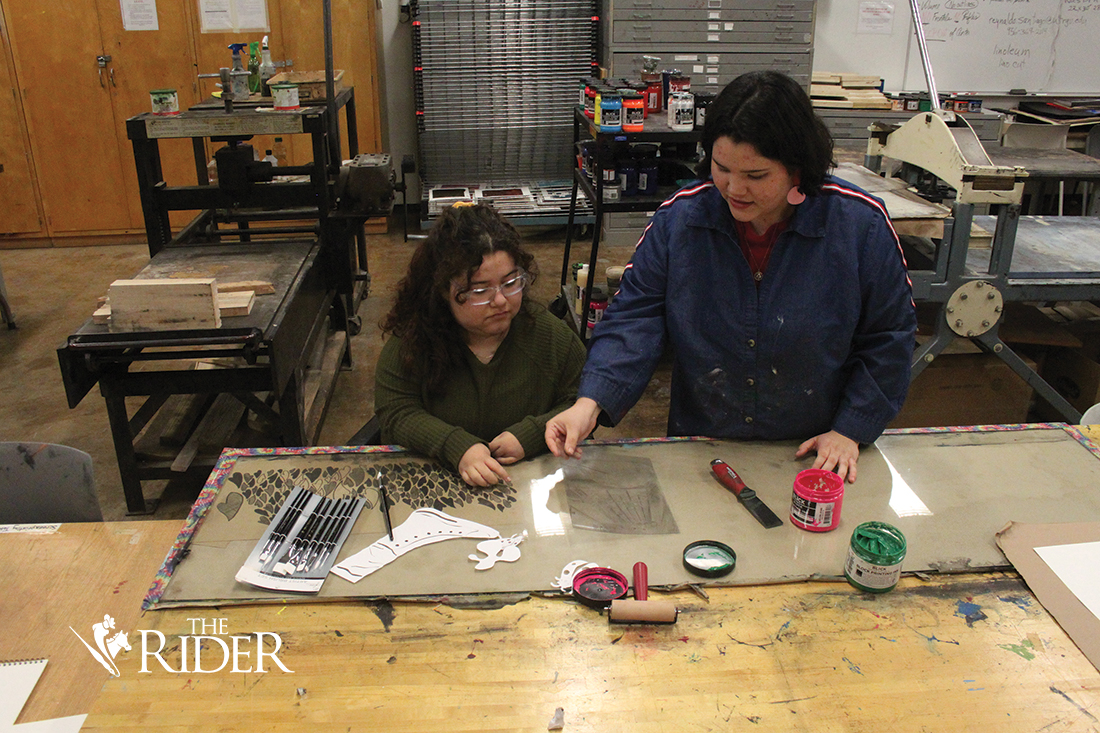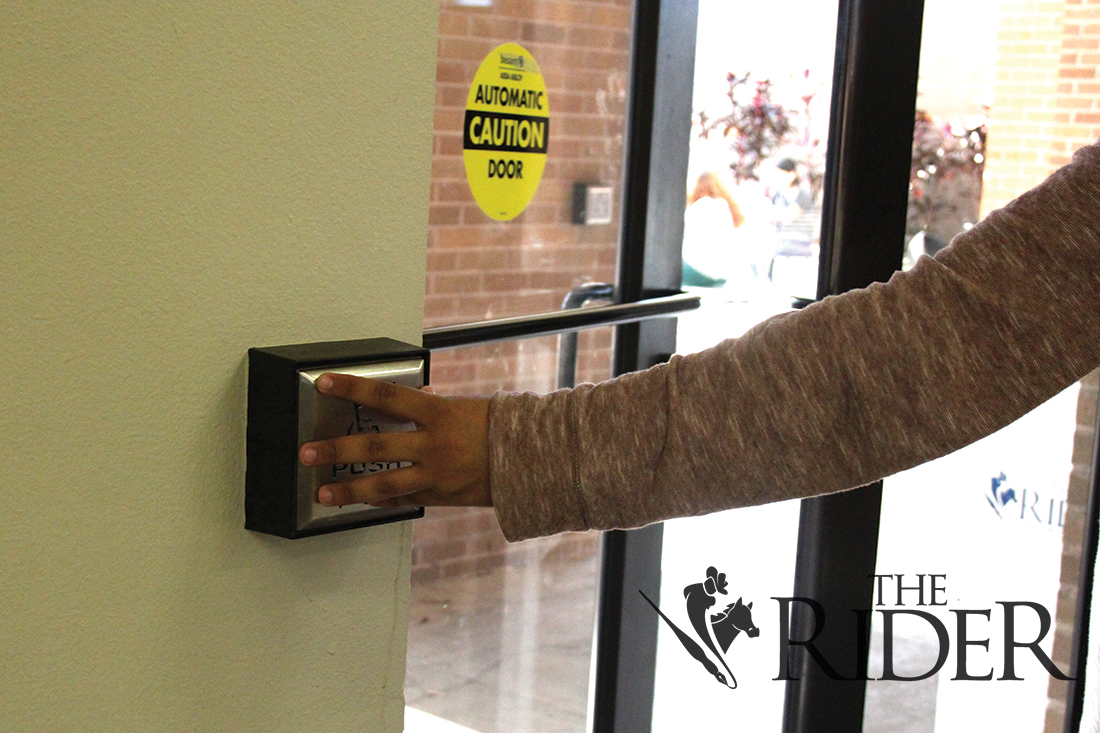
Dámaris Contreras, a studio art junior, was born with arthrogryposis multiplex congenita, which affects joints and muscles.
“I just … can’t walk, and I need help with my arms,” Contreras said.
She has attended UTRGV for the last three years and has encountered accessibility problems across campus, from doors being inaccessible to not finding assistive tables and just feeling like an afterthought.
This semester, Contreras needed assistance in her printmaking class, and her friend, Alejandra Martinez, an art education senior, volunteered through the Student Accessibility Services office to help accommodate her.
Martinez said their friendship started from Contreras asking for help in a drawing class they had together.

“It started off as a suggestion to the office, so we weren’t even sure if that was something that they offered,” Martinez said. “It’s just something that I thought, ‘Well, since I have my class off, I can help her during this class period. So, we went to go ask the office, and they said it was totally fine, as long as the professor knew about it, and there was the accommodations that were taking place.”
She said she helps Contreras with simple things like getting materials, putting them away and anything else that is inaccessible for her to do.
“There’s a lot of things that are inaccessible, but I’m here to accommodate them,” Martinez said. “I want for her to feel comfortable.”
Vita G. Villanueva, Contreras’ mother, said her concern is when she needs help in a classroom. An ongoing issue Villanueva has noticed is when daughter asks for or gets help in a classroom, she said people have this perception that the assistance will be doing the work for her.
“They’re always asking her if they’re going to do the job for you, but no, they’re just going to help her,” Villanueva said. “It’s very different from doing the work for her and helping her. … For example, she can’t get her backpack, she can’t get certain things, but she does all the work.”
Contreras said she is bothered when questions are asked about who is doing the work.
“I feel like they discredit what I do and, like, sometimes I feel like I worked extra hard … but I don’t say that to, like, get more attention,” she said.
Tonya Paulette, the director of Student Accessibility Services, said the office works with students on a case-by-case basis to accommodate their needs.
“We serve students with all types and categories of disabilities, everything from physical health, medical issues, to mental health, learning disabilities,” Paulette said. “There’s a long list of them, really any type of disability.”
An example would be people using wheelchairs to navigate around campus.
“We might look at an accommodation that would allow them to arrive late to class or leave early to class,” she said.
Asked if Student Accessibility Services has a service to help people like Contreras, Paulette replied that is something institutions of higher education are not required to provide for the student.
“When it comes to someone who assists a student … maybe you have someone who is using a wheelchair, and they have limited mobility, let’s say upper body or whatever, then they might require assistance in … retrieving a book from their backpack,” she said. “That would be the role of what a personal care attendant would be able to assist that student with, but that’s not something really that our institution would be responsible for providing, but the student’s responsibility.”
Jesmil M. Maldonado Rodriguez, a part-time faculty member who teaches the printmaking course Contreras is in, said it is important for students to receive these accommodations.
“In her case, it’s about not penalizing her for being late to class and to make sure that she has a nice spot for her to sit and work,” Rodriguez said.
This is not the only accommodation Rodriguez has encountered.
“I have a student that I have to wear a specific microphone for her to receive everything in her phone that I’m saying,” she said.
Rodriguez said it would be a good idea for Student Accessibility Services to visit the Visual Arts Building and let students know about accommodations.
“If they could guide us through the different technologies that are available for them, maybe we’ll have a better understanding,” she said.
Liliana Sanchez, Access Services librarian, said they offer services that help students with any type of disability.
“Whether it is approaching someone at our front desks, at both locations, our staff is able to retrieve material for them and if the student’s unable to go … to our second or third-floor area, we do have that type of assistance and where our staff can help them retrieve any physical item, whether it be a book or anything available outside from the first-floor area,” Sanchez said.
The library offers a variety of services from special study rooms for people with disabilities, accessibility computer stations and Braille resources.
“Our priority is always to have and provide a similar service at both locations, keeping in mind that the students not only commute from one campus to the other, but the demand has always been if something is offered on campus, obviously, it’s going to be useful for the student and another campus,” she said.
Contreras said there is always something you can improve on, especially with the accommodations that are offered to people with disabilities.
“We’re always left out of a lot of things, and I feel like if there was a group of us … we can go to, like, whoever’s in charge and, like, tell them.”
Villanueva said the school needs more modifications to receive certain types of students.
“The school should adapt to them, not them to the school,” she said.
Accessibility throughout campuses through the use of ramps, elevators and other devices are essential for people with disabilities.
Jesus “Jesse” Medina, an administrative assistant for the sociology department who has paraplegia, has been working at the university since 2006 and has faced problems when not being able to use these devices.
“There [are] elevator issues within campus that sometimes we have to stay within the same floor,” Medina said. “That’s it. We can’t do nothing about it or we have to call it in, and services are not coming in until hours later, or they can’t do nothing about it.”
He said he recalled a morning where both elevators in the Liberal Arts Building North were not working and he stayed on the first floor for several hours until they fixed it.
“It’s nerve-racking,” Medina said. “There’s lots of other students that have been trapped inside the elevators. It’s a common occurrence within our building.”
He said he encountered another issue where the power went out, and he had to go down the stairwell.
“There was nobody around, it was five o’clock, apparently the power went out,” Medina said. “Sprint wasn’t working, our telephones work by internet and by electricity, so all that went out. We couldn’t call anybody, so, it was a crazy day.”
He has also seen accessibility ramps on campus that are not wheelchair accessible or are in poor condition.
Marta Salinas-Hovar, associate vice president for Facilities Planning and Operations, said the university has a contract with a vendor that conducts regular routine maintenance of the elevators to make sure they work.
“When we get calls that elevators are down, we get dispatch people right away from our maintenance staff and go out right away, and then we immediately also call the vendor, so they can come out and service it,” Salinas-Hovar said.
Medina said he is also concerned about the preparation in case of a fire.
“That’s one thing that I fear the day that will come,” he said. “If there is a wheelchair person [in] this building that is not able to move the way I do, there’s going to be issues.”
Sanchez said the library is proactive in making sure that staff attends training involving these scenarios and cases.
She said if a staff member is out of the building during an emergency evacuation, they contact campus police, the fire department or anyone available to inform them that there is a student who needs assistance in exiting the building.
“There are other techniques that we’ve been trained [in],” Sanchez said. “I don’t know if you’re familiar with the buddy technique and where staff members assist a patron through this buddy technique by locking their hands and being able to facilitate the student downstairs.”
She said it is the same protocol if there is a power outage and a student needs assistance going downstairs.
Medina encourages UTRGV to learn from students’ experiences to better accommodate them.
“Adapt to it,” he said. “So that way, they’ll be more prepared for future students that might need that particular equipment. Just learn from it.”







